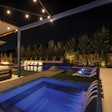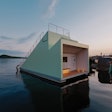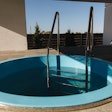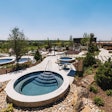T.J. Moreland is business development manager for Merlin Industries in Hamilton, N.J., a diversified company that makes vinyl liners, safety pool covers, spa covers — and even its own electricity by means of a massive array of solar panels on the roof of its factory. AQUA spoke with Moreland recently about the company’s green initiatives.
You guys make a range of products, but let’s concentrate on the hot tub side of things. Is being green important to today’s hot tub shopper?
I think there’s definitely an increase in that thought process and you can see that by the number of green products, like chemicals, that are coming out that are more environmentally conscious, or products that are made with natural ingredients like SeaKlear’s, which is made from crustacean shells.
As a manufacturer, we look at what we can do for the environment as far as recycled materials and things like that, and unfortunately we’re kind of pressed to use virgin materials and not use anything recycled. We reached out to see what else we could do, so we went solar in the plant. But you are seeing more and more green products. As with anything it takes a little time for things to be adopted, and I think our industry can be a little bit slow to change. But when you look at the shows and they are selling space for products that are green, it’s evident that things are changing.
So using recycled vinyl would put you at a competitive disadvantage?
It’s not popular yet, and if a company uses recycled or reground products, that’s marketed against. That said, we do recycle a majority of our scrap vinyl that we use for the bottom of our spa covers, and the marine-grade vinyl as well as the foam inserts and sell all that back for use in other industries.
For years there’s always been a connotation that a recycled product is cheaper and not as good as a virgin product, and in some cases that’s probably true, and in other cases it’s actually not — some of the reground materials actually have better characteristics than some of the non-recycled products. When they make a big mix of recycled materials, there are materials of all grades getting recycled, so you’re getting some of the benefits of that higher-end material in the recycled material. Maybe if the mind set would change a little bit toward that way of thinking people would understand that recycled can be better. But for right now, we still continue to use virgin material.
Are there things that designers are doing to increase the thermal efficiency of hot tub covers?
We actually just came out with a new product called the Spa Jacket. The reason we came up with that is that the percentage of fully foamed spas on the market is very low. A lot more of the new spas have very good insulation factors, but a lot of the older ones out there do not. So, basically a company in Canada came up with the Spa Jacket, and we’re the licensed manufacturer in the United States. It’s the same concept as the insulated wrap you put on a hot water heater to make it more energy efficient. If you’ve got a hot tub of 500 or 600 gallons outside in winter climates without full foam, that’s not very efficient. The Spa Jacket is just a wrap on the outside of the spa. It has an R-factor of about 13, so you’re adding real nice insulation to keep heat in. The energy testing that they did showed it can save between 35 and 45 percent of the operating cost of that hot tub during the winter.
From a regular cover standpoint, there’ve been changes like thicker foam to increase the R-values of those a little bit, but this new product does that and a little more. It can take an older spa and make it more aesthetically pleasing if the cabinet is in bad shape, then it also obviously provides that extra insulation on the outside of the hot tub.
Are people hanging onto their covers longer than they should and losing money through heat loss?
No, not really. With the EPS foam I don’t think you really lose any insulation over time. I think people, when they need to spend the money to replace something, they’re willing to spend it. In fact, we’re seeing a bit of an uptick in spending lately. We’re not back at 2006 levels, but I think we’re starting to see people spend more money in their backyards.
When you get into your first or second replacement cover since owning the spa, you’re looking for something a little bit better. So they are willing to spend a little more instead of just replacing it with the same thing that they had before.
Tell me about what you’re doing at the factory.
The first thing we did is come up with an initiative we call ECO, which stands for Environmentally Conscious Organization. That all came about when we started looking into the possibility of converting the plant over to solar power. Basically we’ve got an enormous flat roof that lends itself perfectly to putting solar panels on it. So we contracted with a company and got some government incentive and whatnot and got a system large enough to produce all the power that we use here at the plant. New Jersey is a state that is big on promoting solar and wind, especially solar, so it made a lot of sense for us to give back to the environment and reduce our carbon footprint, and at the same time it was a good investment for the future of the company because of the revenue that the solar power generation provides.
It’s sort of hard to explain, and the program isn’t available in every state, but in New Jersey there’s a specific amount of power that needs to come from renewable sources, so all the power companies in the state have to provide a certain amount of their power from renewables. So, if they’re not generating that power they have to buy it from somewhere. So the state set up something called Solar Renewable Energy Credits, or an S-REC, and those are traded like a commodity on a trading market. For every 100,000 kW that a solar generation station — which we are — generates, we get one credit. And then those credits can be traded, and the electric companies can purchase them on the open market to satisfy the renewable energy needs that they have. We are not literally selling our power; we’re selling the credits that we earned for producing that power. Some other states have also adopted the program, like Ohio and New York, Maryland, California. It’s a program that the states that want to promote solar have put into place.
So the juice you generate doesn’t go right into the factory?
No. What New Jersey has is something called a grid-connected system, which is a little unfortunate because when power goes out you’d think our power would stay on. But it doesn’t. What happens is the panels collect the power, it goes into an inverter, it’s converted into AC power then it gets put back into the grid. There are meters that record how much you put back into the grid. During the day, while we’re generating, our meter is kind of running backwards. Then at night when we’re not generating the meter is running forward. The whole key is to generate more during the day than you’re going to use at night so you have a net gain. Then on top of that you’re got those S-REC benefits.
Comments or thoughts on this article? Please e-mail [email protected].










































